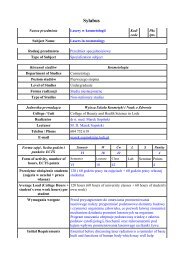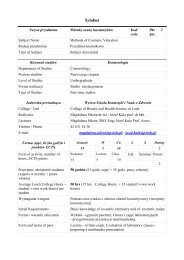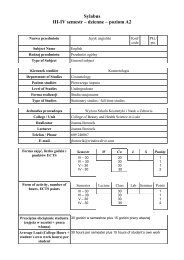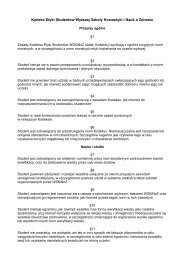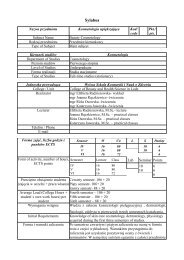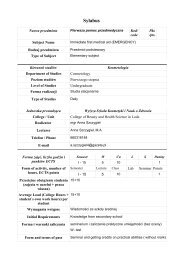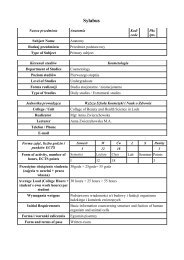immunologia stacjoanrne.pdf - Kosmetologia
immunologia stacjoanrne.pdf - Kosmetologia
immunologia stacjoanrne.pdf - Kosmetologia
Create successful ePaper yourself
Turn your PDF publications into a flip-book with our unique Google optimized e-Paper software.
Sylabus<br />
Nazwa przedmiotu<br />
Subject Name<br />
Rodzaj przedmiotu<br />
Type of Subject<br />
Immunologia<br />
Immunology<br />
Przedmiot podstawowy<br />
Primary subject<br />
Kod/<br />
code<br />
Pkt.<br />
/pts.<br />
Kierunek studiów<br />
Departament of Studies<br />
Poziom studiów<br />
Level of Studies<br />
Forma realizacji<br />
Type of Studies<br />
Cosmetology<br />
Pierwszego stopnia<br />
Undergranduate<br />
Studia stacjonarne<br />
Daily studies<br />
<strong>Kosmetologia</strong><br />
Jednostka prowadząca<br />
College/Unit<br />
Realizatorzy<br />
Lecturer<br />
Telefon/Phone<br />
E-mail<br />
Wyższa Szkoła Kosmetyki i Nauk o Zdrowiu w Łodzi<br />
College of Beauty and Health Science in Lodz<br />
Kierownik przedmiotu:<br />
Prof. nadzw. dr hab. n. med. Janina Łucja Grzegorczyk - wykłady<br />
Asystenci:<br />
Mgr biol. Magdalena Kujawiak – ćwiczenia<br />
Mgr anal. med. Anna Michalak - ćwiczenia<br />
J. Grzegorczyk: tel. 692642012<br />
M. Kujawiak: tel. 517703444<br />
A. Michalak: tel. 606718956<br />
janina_grzegorczyk@op.pl<br />
magdakujawiak@gmail.com<br />
annamichalak7@wp.pl<br />
Formy zajęć, liczba godzin i<br />
punktów ECTS<br />
Form of activity, number of<br />
hours, ECTS points<br />
Przeciętne obciążenie studenta<br />
(zajęcia w uczelni + praca własna)<br />
Awerage Load (College Hours<br />
+ student’s own work hours)<br />
per student<br />
Wymagania wstępne<br />
Initial Requirements<br />
Formy i warunki zaliczenia<br />
Form and terms of pass<br />
Semestr W Ć L S Punkty<br />
V 12 18 0 3<br />
Semester Lecture Class Lab Seminar Points<br />
V 12 18 0 3<br />
30+45<br />
30+45<br />
Budowa i funkcjonowanie układu immunologicznego.<br />
Structure and function of the immune system.<br />
Egzamin pisemny<br />
Written exam<br />
1
Cele kształcenia (wiedza,<br />
umiejętności, kompetencje<br />
społeczne)<br />
Celem przedmiotu jest zapoznanie studentów z budową układu<br />
odpornościowego człowieka i funkcją jego komórek,<br />
z przebiegiem reakcji immunologicznych, odpowiedzią<br />
immunologiczną swoistą i nieswoistą, głównym układem zgodności<br />
tkankowej, regulacją odpowiedzi immunologicznej oraz podstawami<br />
diagnostyki immunologicznej.<br />
Student po ukończeniu części teoretycznej ćwiczeń i wykładów<br />
z Immunologii powinien:<br />
− opisać immunoglobuliny ich strukturę i funkcje<br />
− opisać antygeny i ich rodzaje<br />
− opisać układ odpornościowy skóry<br />
− opisać melanocyty jako komórki immunologicznie kompetentne<br />
− opisać rolę komórek dendrytycznych w odpowiedzi immunologicznej<br />
− opisać komórki macierzyste<br />
− opisać reakcje nadwrażliwości<br />
− opisać mechanizmy nadwrażliwości na kosmetyki<br />
− opisać niedobory odporności: wrodzone i nabyte<br />
− opisać różne metody reakcji immunofluorescencyjnych<br />
− opisać metody reakcji immunoenzymatycznych takie jak<br />
ELISA, ELISPOT, APAAP, PAP<br />
− opisać różne techniki immunoelektroforetyczne<br />
− opisać różne metody oceny fagocytozy i chemotaksji<br />
− opisać kalendarz szczepień<br />
− wymienić alergeny środowiskowe<br />
− opisać budowę poszczególnych alergenów<br />
− opisać krzyżowość alergenową<br />
− opisać infekcje wirusowe, które mogą przyczyniać się do<br />
rozwoju alergii<br />
− opisać czynniki cywilizacyjne, które mogą być przyczyną<br />
rozwój alergii<br />
− opisać metody oznaczania kompleksów immunologicznych i<br />
składowych dopełniacza<br />
− opisać znaczenie apoptozy w immunopatologii<br />
− opisać wpływ procesu apoptoza na rozwój alergii<br />
− wymienić fitoestrogeny ich rodzaje, funkcje i właściwości<br />
− opisać oddziaływanie fitoestrogenów na układ<br />
odpornościowy skóry<br />
− opisać zastosowanie fitoestrogenów w kosmetykach<br />
− opisać metody oznaczania antygenów zgodności tkankowej –<br />
PCR, serologiczna<br />
− wymienić rodzaje przeszczepów skóry<br />
− opisać hodowle komórkowe stosowane w kosmetologii<br />
− wymienić olejki eteryczne stosowane w kosmetykach<br />
− opisać wpływ olejków eterycznych w kosmetykach na rozwój<br />
alergii<br />
2
−<br />
−<br />
−<br />
−<br />
opisać reakcje niepożądane na kosmetyki<br />
wymienić zastosowanie poznanych metod w diagnostyce<br />
laboratoryjnej<br />
poszerzać wiedzę z dziedziny Immunologii<br />
stosować uzyskane wiadomości z zakresu Immunologii<br />
w sytuacjach problemowych<br />
Teaching aims (knowledge,<br />
skills, social competence)<br />
Student after completing the theoretical part of the exercise<br />
and lectures of Immunology should:<br />
- describe immunoglobulins, their structure and functions<br />
- describe the types of antigens<br />
- describe the skin's immune system<br />
- describe melanocytes as immunologically competent cells<br />
- describe the role of dendritic cells in the immune<br />
response<br />
- describe stem cells<br />
- describe hypersensitivity reactions<br />
- describe the mechanisms of hypersensitivity to cosmetics<br />
- describe immunodeficiency: congenital and acquired<br />
- describe different methods of immunofluorescence<br />
reaction<br />
- describe the immunoenzymatic methods such as ELISA,<br />
ELISPOT, APAAP, PAP<br />
- describe different immunoelectrophoretic techniques<br />
- describe different methods for the evaluation of<br />
phagocytosis and chemotaxis<br />
- describe immunization calendar<br />
- mention environmental allergens<br />
- describe the construction of individual allergens<br />
- describe crossreactivity of allergens<br />
- describe viral infections, which may contribute to the<br />
development of allergies<br />
- describe the factors of civilization, which can influence<br />
the development of allergies<br />
- describe methods for the determination of immune<br />
complexes and complement components<br />
- describe the importance of apoptosis in the<br />
immunopathology<br />
- describe the process of apoptosis and influence on the<br />
development of allergies<br />
- mention phytoestrogens and describe their types,<br />
functions and properties<br />
- describe the effects of phytoestrogens on the immune<br />
system of the skin<br />
- describe the use of phytoestrogens in cosmetics<br />
- describe methods for the determination of<br />
histocompatibility antigens - molecular, serological<br />
- mention types of skin grafts<br />
- describe cell cultures used in cosmetology<br />
- describe the epidemiology of hypersensitivity to<br />
cosmetics<br />
3
- name the essential oils in cosmetics<br />
- describe the effect of essential oils in cosmetics for the<br />
development of allergies<br />
- describe adverse reactions to cosmetics<br />
- describe the use of known methods in laboratory<br />
diagnostics<br />
- enhance knowledge in the field of Immunology<br />
- use the obtained information from the Immunology in<br />
problematic situations<br />
Program ramowy przedmiotu<br />
Wykłady:<br />
1. Budowa układu odpornościowego.<br />
2. Immunoglobuliny – struktura i funkcje.<br />
3. Antygeny- rodzaje. Przetwarzanie antygenu i współudział<br />
komórek w odpowiedzi immunologicznej.<br />
4. Układ odpornościowy skóry<br />
5. Melanocyty – komórki immunologicznie kompetentne<br />
6. Rola komórek dendrytycznych w odpowiedzi immunologicznej.<br />
7. Komórki macierzyste – za i przeciw.<br />
8. Hormony a odporność – immunologiczny wykładnik starzenia .<br />
9. Reakcje nadwrażliwości – mechanizmy nadwrażliwości na<br />
kosmetyki.<br />
10. Niedobory odporności: wrodzone i nabyte.<br />
Ćwiczenia:<br />
1. Metody wykorzystywane w diagnostyce immunologicznej:<br />
immunofluorescencja pośredniej i bezpośredniej, cytometria<br />
przepływowa, testy immunoenzymatyczne: ELISA, APAP,<br />
PAP.<br />
2. Odporność w zakażeniach pasożytniczych, bakteryjnych.<br />
Chemotaksja, fagocytoza, killing – metody oceny. Szczepionki.<br />
3. Alergeny środowiskowe; budowa, krzyżowość. Infekcje wirusowe<br />
a alergie. Czynniki cywilizacyjne a rozwój alergii.<br />
4. Metody oznaczania kompleksów immunologicznych i składowych<br />
dopełniacza. Znaczenie apoptozy w immunopatologii.<br />
5. Fitoestrogeny: rodzaje, funkcje, właściwości. Oddziaływanie<br />
fitoestrogenów na układ odpornościowy skóry.<br />
Zastosowanie fitoestrogenów w kosmetykach.<br />
6. Metody oznaczania antygenów zgodności tkankowej – PCR,<br />
serologiczna. Immunologia przeszczepów skóry. Hodowle<br />
komórkowe w kosmetologii.<br />
7. Epidemiologia nadwrażliwości na kosmetyki. Olejki eteryczne<br />
w kosmetykach a alergia. Reakcje niepożądane na kosmetyki.<br />
4
Overall teaching Plan<br />
Lecture<br />
1. Construction of the immune system.<br />
2. Immunoglobulins - structure and functions.<br />
3. Types of antigens. Antigen processing by immunocompetent<br />
cells and influence on the immune response.<br />
4. Skin's immune system.<br />
5. Melanocytes - cells immunologically competent<br />
6. The role of dendritic cells in the immune response.<br />
7. Stem cells - the pros and cons.<br />
8. Hormones and immunity - immune aging exponent.<br />
9. Hypersensitivity reactions - mechanisms of hypersensitivity to<br />
cosmetics.<br />
10. Immunodeficiency: congenital and acquired.<br />
Exercise<br />
1. Methods used in the immunological diagnostics: direct and<br />
indirect immunofluorescence, flow cytometry, immunoenzymatic<br />
tests: ELISA, APAP, PAP.<br />
2. Immunity in parasitic, viral and bacterial infections. Chemotaxis,<br />
phagocytosis, killing and the methods of their assessment. The<br />
vaccine.<br />
3. Environmental allergens, construction, cross-reactions. Viral<br />
infections and allergies. Factors of civilization and the<br />
development of allergies.<br />
4. Methods used for determination of immune complexes and<br />
complement components. The importance of apoptosis in<br />
immunopathology. Apoptosis and allergy.<br />
5. Phytoestrogens: types, functions, properties. Effects of<br />
phytoestrogens on the skin's immune system. The use of<br />
phytoestrogens in cosmetics.<br />
6. Methods used for determination of histocompatibility antigens –<br />
molecular (PCR), serological. Immunology of skin grafts.<br />
Cell cultures in cosmetology.<br />
7. Epidemiology of hypersensitivity to cosmetics. Essential oils in<br />
cosmetics and allergy. Adverse reactions to cosmetics.<br />
Metody dydaktyczne<br />
Methodology measures<br />
Wykłady - prezentacje multimedialne<br />
Ćwiczenia - prezentacje multimedialne<br />
Lectures - multimedia presentations<br />
Exercises - multimedia presentations<br />
Efekty kształcenia (wiedza,<br />
umiejętności, kompetencje<br />
społeczne)<br />
Student po ukończeniu części teoretycznej wykładów i ćwiczeń<br />
z Immunologii prawidłowo:<br />
− opisuje immunoglobuliny ich strukturę i funkcje<br />
− opisuje antygeny i ich rodzaje<br />
− opisuje układ odpornościowy skóry<br />
− opisuje melanocyty jako komórki immunologicznie kompetentne<br />
5
−<br />
−<br />
−<br />
−<br />
−<br />
−<br />
−<br />
−<br />
−<br />
−<br />
−<br />
−<br />
−<br />
−<br />
−<br />
−<br />
−<br />
−<br />
−<br />
−<br />
−<br />
−<br />
−<br />
−<br />
−<br />
−<br />
−<br />
−<br />
−<br />
−<br />
opisuje rolę komórek dendrytycznych w odpowiedzi immunologicznej<br />
opisuje komórki macierzyste<br />
opisuje reakcje nadwrażliwości<br />
opisuje mechanizmy nadwrażliwości na kosmetyki<br />
opisuje niedobory odporności: wrodzone i nabyte<br />
opisuje różne metody reakcji immunofluorescencyjnych<br />
opisuje metody reakcji immunoenzymatycznych takie jak<br />
ELISA, ELISPOT, APAAP, PAP<br />
opisuje różne techniki immunoelektroforetyczne<br />
opisuje różne metody oceny fagocytozy i chemotaksji<br />
opisuje kalendarz szczepień<br />
wymienia alergeny środowiskowe<br />
opisuje budowę poszczególnych alergenów<br />
opisuje krzyżowość alergenową<br />
opisuje infekcje wirusowe, które mogą przyczyniać się do<br />
rozwoju alergii<br />
opisuje czynniki cywilizacyjne, które mogą być przyczyną<br />
rozwój alergii<br />
opisuje metody oznaczania kompleksów immunologicznych<br />
i składowych dopełniacza<br />
opisuje znaczenie apoptozy w immunopatologii<br />
opisuje wpływ procesu apoptoza na rozwój alergii<br />
wymienia fitoestrogeny ich rodzaje, funkcje i właściwości<br />
opisuje oddziaływanie fitoestrogenów na układ<br />
odpornościowy skóry<br />
opisuje zastosowanie fitoestrogenów w kosmetykach<br />
opisuje metody oznaczania antygenów zgodności tkankowej<br />
– PCR, serologiczna<br />
wymienia rodzaje przeszczepów skóry<br />
opisuje hodowle komórkowe stosowane w kosmetologii<br />
opisuje epidemiologię nadwrażliwości na kosmetyki<br />
wymienia olejki eteryczne w kosmetykach<br />
opisuje wpływ olejków eterycznych w kosmetykach na<br />
rozwój alergii<br />
opisuje reakcje niepożądane na kosmetyki<br />
wymienia zastosowanie poznanych metod w diagnostyce<br />
laboratoryjnej<br />
stosuje uzyskane wiadomości z zakresu Immunologii<br />
w sytuacjach problemowych<br />
Educational Effects<br />
(knowledge, skills, social<br />
competence)<br />
Student after completing the theoretical part of lectures and<br />
exercises of Immunology properly:<br />
- describes immunoglobulin, their structure and functions<br />
- describes the types of antigens<br />
- describes the skin's immune system<br />
- describes melanocytes as immunologically competent<br />
cells<br />
- describes the role of dendritic cells in the immune<br />
response<br />
6
- describes stem cells<br />
- describes hypersensitivity reactions<br />
- describes the mechanisms of hypersensitivity to<br />
cosmetics<br />
- describes immunodeficiency: congenital and acquired<br />
- describes different methods of immunofluorescence<br />
reaction<br />
- describes the immunoenzymatic methods such as ELISA,<br />
ELISPOT, APAAP, PAP<br />
- describes different immunoelectrophoretic techniques<br />
- describes different methods for the evaluation of<br />
phagocytosis and chemotaxis<br />
- describes immunization calendar<br />
- mentions environmental allergens<br />
- describes the construction of individual allergens<br />
- describes allergen crossreactivity<br />
- describes viral infections, which may contribute to the<br />
development of allergies<br />
- describes the factors of civilization, which can cause the<br />
development of allergies<br />
- describes methods used for the determination of immune<br />
complexes and complement components<br />
- describes the role of apoptosis in the immunopathology<br />
- describes the process of apoptosis influence on the<br />
development of allergies<br />
- mentions phytoestrogens and their types, functions and<br />
properties<br />
- describes the effects of phytoestrogens on the skin's<br />
immune system<br />
- describes the use of phytoestrogens in cosmetics<br />
- describes methods used for the determination of<br />
histocompatibility antigens - PCR, serological<br />
- mentions types of skin grafts<br />
- describes cell cultures used in cosmetology<br />
- describes the epidemiology of hypersensitivity to<br />
cosmetics<br />
- mentions the essential oils in cosmetics<br />
- describes the effect of essential oils in cosmetics for the<br />
development of allergies<br />
- describes adverse reactions to cosmetics<br />
- mentions the use of known methods in laboratory<br />
diagnostics<br />
- enhances knowledge in the field of Immunology<br />
- use the obtained information from the Immunology in<br />
problematic situations<br />
7
Literatura podstawowa<br />
„Immunologia”. Praca zbiorowa pod redakcją Prof. Jana<br />
Żeromskiego, Poznań 2008r.<br />
Core Reading<br />
"Immunology". Collective work edited by Prof.. John Żeromskiego,<br />
Poznań 2008.<br />
Literatura uzupełniająca<br />
„Immunologia Kliniczna”. Praca zbiorowa pod redakcją Prof. Marka<br />
L. Kowalskiego. Łódź 2000r.<br />
Additional Reading "Clinical Immunology". Collective work edited by Prof. Mark L.<br />
Kowalskiego. Lodz 2000.<br />
Uwagi<br />
Remarks<br />
Data opracowania 26.01.2012<br />
Date of Update 26.01.2012<br />
Podpis wykładowcy<br />
Lecturer’s Signature<br />
8



